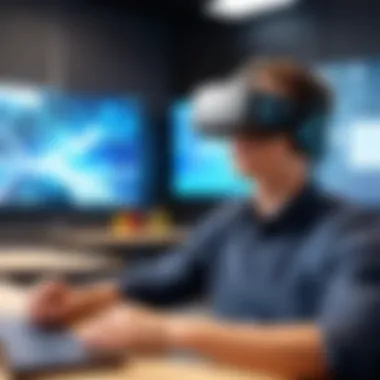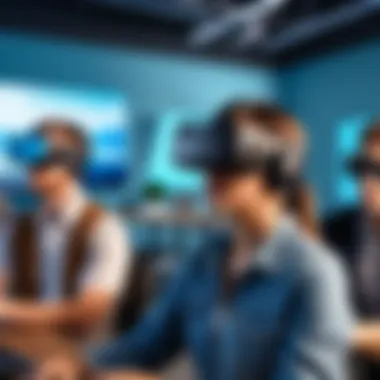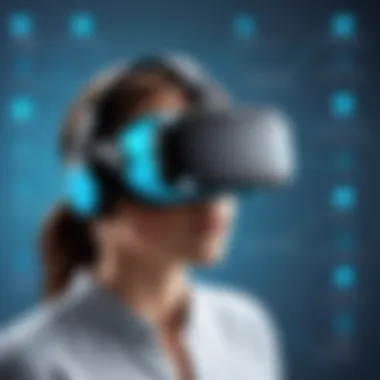Exploring Nearpod VR: Revolutionizing Education Through Immersion


Intro
In today’s fast-paced world, where digital innovation is reshaping every aspect of our lives, education stands at the forefront of this transformation. The traditional classroom is undergoing a significant overhaul, shifting towards more engaging, interactive, and immersive learning experiences. This evolution is largely fueled by advancements in technology, particularly through platforms like Nearpod VR.
Nearpod VR integrates virtual reality with educational content, offering students a chance to step beyond the confines of their classrooms and experience learning in an unprecedented way. Imagine a history lesson where students are not just reading about ancient civilizations but walking through them in a virtual environment. This platform is not merely an add-on; it reshapes how educators teach and how students learn. By turning abstract concepts into tangible experiences, Nearpod VR effectively addresses varied learning styles, thereby enhancing retention and understanding.
As we explore the features, benefits, and strategies of implementing Nearpod VR, it's vital to understand the landscape it operates within. The current educational trends underscore a growing desire for technology that supports enhanced engagement and accessibility. Moreover, as we delve into this article, we will touch upon practical considerations for schools and educators eager to adopt immersive technologies. The aim is to not just highlight the functionality of Nearpod VR but also to understand its impact on the educational methodologies of the digital age.
Preface to Nearpod VR
Nearpod VR marks a significant intersection of technology and education, breathing new life into traditional teaching methods. This section aims to unpack the essence of Nearpod VR, delving into how it integrates virtual reality into the learning process, thereby creating both dynamic and immersive educational environments. The growing relevance of technology in education has transformed how information is conveyed and absorbed, making it essential for today's educators to adapt to these changes.
Defining Nearpod VR
Nearpod VR is an innovative educational platform that utilizes virtual reality to create interactive and engaging lessons. This tool not only enhances learning experiences but also fosters deeper understanding and retention of knowledge. With Nearpod VR, teachers can construct lessons that transport students to different environments, offering an experience that mere textbooks or standard classroom settings cannot provide. For instance, imagine high school students exploring the ancient ruins of Machu Picchu without leaving their classroom. This type of resource not only makes the learning experience memorable but also allows for a level of engagement that encourages participation and critical thinking.
The integration of Nearpod VR can redefine how subjects like science, history, and geography are taught. By making complex or distant concepts tangible through immersive experiences, educational growth can be accelerated, catering to various learning styles as well. The tool is designed to be user-friendly, inviting both students and teachers to explore and interact within this inclusive digital landscape.
The Evolution of Virtual Reality in Education
The journey of virtual reality in education has been nothing short of remarkable. From its rudimentary beginnings, where simulation was limited and basic, we have arrived at a point where VR can offer fully immersive learning experiences. The advent of sophisticated technologies has allowed VR to reach its potential in classrooms today.
In the early days, educators were hesitant to embrace VR due to its high costs and technical barriers. However, as technology advanced, so too did the accessibility of VR tools. Furthermore, the advent of affordable headsets and devices has played a significant role in its adoption across various educational settings.
Virtual reality started to gain traction in higher education, initially seen in specialized fields such as medicine or engineering, where realistic simulations are critical for training. Now, however, it has spread to K-12 classrooms as well. Teachers readily use VR not just as a supplementary tool but as a core component of their curriculum, enriching the educational landscape.
"As technology progresses, the potential for virtual reality in the classroom appears limitless."
This evolution signifies a paradigm shift in pedagogical approaches, where education is not just about transmitting knowledge but engaging in active exploration. The way forward suggests a promising trend where VR can, and likely will, be ubiquitous in education, challenging educators to think creatively and adaptively about how they teach.
Core Features of Nearpod VR
The landscape of education has been rapidly reshaped by technology, and Nearpod VR stands as a prime example of this transformation. Understanding the core features of Nearpod VR goes a long way in grasping how it enriches the educational experience. This section will break down the fundamental aspects that make it a powerful tool for both educators and students.
Interactive Lessons
Interactive lessons are at the heart of Nearpod VR’s appeal. With its ability to blend traditional teaching methods with immersive content, Nearpod encourages higher levels of participation from students. Teachers can create lessons that are visually stimulating, pulling students in rather than just talking at them. The platform allows for interactive slides, where students can engage with the content via quizzes, polls, and activity slides. This not only makes learning more engaging but also helps in retaining information.
For instance, imagine a history lesson where students can not only read about ancient Rome but also visit a virtual recreation of the Colosseum. This kind of active participation allows students to create their own mental connections to the material, making learning feel more like an adventure than a chore.
Real-Time Assessment Tools
The integration of real-time assessment tools sets Nearpod VR apart from traditional educational tools. Educators can gauge students' understanding instantaneously through various assessment options—be it polls that take the room's temperature on a topic or quick quizzes that reveal who is grasping the material and who might need extra help.
These tools make it far easier to adapt lessons on the fly. If many students struggle with a particular concept, teachers can immediately dive back into that topic, ensuring no one is left behind. Such adaptability is invaluable in today’s diverse classroom settings, where students often come with different learning rates and styles.
"Real-time feedback is like having eyes in the back of your head for educators, helping them navigate complex topics with confidence."
Immersive Experiences and Content Variety
What truly makes Nearpod VR a standout tool is its ability to offer immersive experiences and a rich variety of content. With access to 3D virtual field trips and simulations, students can step inside a cell, explore the solar system, or even dive into the depths of an ocean—all from their classrooms. This variety not only caters to visual and kinesthetic learners but also brings abstract concepts into a context that's easier to grasp.
Moreover, the content isn't stagnant; it's continually updated and improved. Teachers can customize lesson materials, incorporating their personal touch while aligning with state standards. By mixing and matching from a library of resources, including videos, assessments, and interactive activities, educators become curators of an engaging and relevant learning environment.
In capturing the essence of Nearpod VR’s core features, one can appreciate how the platform is more than just a tool—it's a catalyst for a new era in education. These features empower educators to create engaging learning experiences while continuously assessing and personalizing learning paths for their students.
Benefits of Implementing Nearpod VR
The integration of Nearpod VR into educational frameworks showcases its potential to revolutionize the way teaching and learning occur. Embracing technology such as this not only enhances the interactions between students and the curriculum but also addresses varied educational needs and preferences. As the educational landscape transforms, the importance of exploring these benefits becomes paramount.
Enhancing Student Engagement


When students are engaged, they learn better. Nearpod VR does not just rely on traditional teaching methods; it pulls learners into a world where they can see, hear, and even feel the content being taught. Imagine a student going on a virtual field trip to an ancient civilization instead of reading about it in a textbook. This experiential learning can spark curiosity and interest like no other.
Key ways in which Nearpod VR enhances engagement include:
- Interactive Content: Lessons are not just one-way streets with information being fed to students. Instead, learners become part of the narrative, making choices and exploring concepts interactively.
- Gamified Learning: Incorporating elements of gaming into the lessons creates excitement. Students can feel the thrill of competition or the satisfaction of accomplishment as they progress through educational mini-games that are part of the VR experience.
- Increased Retention: Engaging and immersive experiences lead to longer-lasting learning. A study suggested that students retain up to 90% of what they do or simulate, compared to about 10% from traditional lectures.
"The power of experience is unmatched, and Nearpod VR taps directly into that potential."
Facilitating Diverse Learning Styles
Not every student learns the same way. Some are visual learners, others prefer auditory inputs, while some thrive on hands-on activities. Nearpod VR caters to these diverse learning styles through its rich content delivery. Whether through vibrant visuals, detailed audio narrations, or interactive simulations, it meets learners where they are.
Some notable aspects include:
- Visual Learning: With immersive environments, visual learners can grasp concepts more effectively, seeing environments or processes in a three-dimensional space that aids understanding.
- Kinesthetic Learning: For students who learn by doing, Nearpod VR allows them to engage directly with digital environments, turning abstract ideas into tangible experiences.
- Auditory Support: Narrations and discussions can be embedded in VR lessons, allowing auditory learners to absorb content in ways that best suit them.
Such adaptability ensures every student has the opportunity to engage and absorb knowledge effectively, enhancing their overall educational experience.
Promoting Collaborative Learning Environments
Another notable benefit of Nearpod VR is its capability to foster collaboration among students. In today's interconnected age, the ability to work alongside peers is vital. Nearpod VR creates virtual spaces for students to collaborate, regardless of their physical location.
Key features that promote collaborative learning include:
- Shared Experiences: Students can embark on virtual adventures together, discovering elements of their lessons in sync, allowing for simultaneous discussions and shared insights.
- Team-Based Activities: Group tasks and challenges can be built into VR lessons, encouraging teamwork and problem-solving skills, essential in real-life contexts.
- Peer Feedback Options: Virtual platforms in Nearpod allow for real-time feedback from classmates. This can teach students not only to provide constructive criticism but also to appreciate different perspectives.
As learning becomes more collaborative, students develop the interpersonal skills necessary for their future careers. Nearpod VR thus plays a significant role in shaping not just individual scholars but well-rounded, team-oriented individuals.
As we delve into the implications of Nearpod VR, it becomes clear that its myriad benefits touch on core educational needs, paving the way for a brighter, more engaging learning future.
Challenges in Adopting Nearpod VR
The integration of Nearpod VR into educational systems is not without its hurdles. While this technology promises to revolutionize learning experiences, various challenges impede its seamless adoption. Understanding these obstacles is essential for educators and administrators who wish to enhance their methodologies with innovative solutions. Addressing concerns like technical limitations, the need for teacher training, and curriculum integration can pave the way for successful implementation and ultimately improve student engagement and outcomes.
Technical Limitations and Accessibility
One of the most significant considerations when adopting Nearpod VR involves technical limitations. Not every school has the infrastructure required to support virtual reality experiences effectively. Insufficient internet bandwidth can hinder performance, leading to laggy content and a frustrating user experience. Furthermore, the hardware requirements for VR setups—like headsets and compatible devices—can escalate costs quickly.
Notably, accessibility becomes a cornerstone of effective VR adoption. Ensuring that all students, regardless of ability, have access to VR technology is crucial. This means not only providing adequate hardware but also ensuring that content is designed with accessibility in mind. As VR can be overwhelming for some learners, customizable options that cater to diverse needs must be prioritized.
"Tech can be the great equalizer, but only if we provide equal access to it."
Training Needs for Educators
Even with the right technology in place, educators find themselves in a bind if they haven't received proper training. Nearpod VR isn't just a plug-and-play solution; it requires a shift in how educators think about lesson planning and delivery. The dynamics of facilitating immersive experiences differ greatly from traditional teaching methods. Therefore, professional development programs that focus on VR pedagogies are vital for teachers to maximize the potential of this technology.
Additionally, constant updates and advancements in technology necessitate ongoing training. Teachers need access to continuous professional development not only to stay current with updates in Nearpod VR but also to explore new strategies tailored for immersive education.
- Key aspects of educator training include:
- Familiarity with VR equipment
- Understanding of immersive pedagogies
- Strategies for fostering student collaboration in VR settings
Curriculum Integration Concerns
To harness the full potential of Nearpod VR, thoughtful integration into the curriculum is essential. Schools can’t simply bolt on VR as an afterthought; instead, it needs to be woven into the fabric of learning objectives and outcomes. This may require curricular redesign, which could be a daunting task for educators who are already pressed for time.
Moreover, aligning VR content with existing educational standards is critical. Teachers must ensure that the immersive experiences are not just engaging but also educationally relevant. As near-practical content can vary widely, a curriculum that accommodates VR while still meeting state guidelines is paramount.
An approach that prioritizes collaboration between teachers, educational leaders, and content developers will facilitate smoother integration. This connects educators with VR content that fulfills specific learning goals while also encouraging innovation in lesson plans.
In summary, while the adoption of Nearpod VR carries challenges, logical and strategic planning can mitigate these issues. By taking the time to address technical, training, and curricular barriers, schools can not only adopt this pioneering technology but also thrive in a landscape that is rapidly shifting toward immersive learning.


Integrating Nearpod VR in the Classroom
Integrating Nearpod VR into the classroom environment is not just an add-on; it is a transformative leap into a new learning paradigm. This section delves into its importance, highlighting essential elements and benefits that come with the effort of weaving immersive technology into the educational fabric.
When we think about Nearpod VR, consider it as a bridge—connecting students with immersive experiences that textbooks simply cannot match. Engaging students through realistic simulations or interactive environments can elevate understanding and retention. With the push for personalized education on the rise, incorporating Nearpod VR helps accommodate diverse learning styles, making sure no student gets left out in the cold.
One of the significant advantages is enhancing engagement. Students often find traditional methods monotonous. Nearpod VR reinvigorates the curriculum by presenting lessons in a vivid manner. Picture a history class where students can walk through ancient Rome or a science lesson where they can explore the human body from the inside. This sense of presence and exploration is a game changer.
Furthermore, integrating this platform supports collaboration among peers, fostering an interactive learning community. When students partake in group activities within a virtual realm, they can bond over shared experiences, helping each other grasp complex concepts. This social aspect is crucial, especially in a time when individual learning paths are prevalent.
However, it's also essential to consider logistical aspects when integrating Nearpod VR. Ensuring access to suitable hardware, internet connectivity, and training for educators plays a pivotal role in the successful implementation of this technology.
"Technology is best when it brings people together," as Matt Mullenweg once said, highlighting that effective integration is not just about tools but about the relationships formed through them.
Strategies for Effective Implementation
The implementation process is where the rubber meets the road. Effective strategies are essential to harness the full potential of Nearpod VR. First off, educators must thoroughly assess their classroom's technological readiness. This involves checking network capabilities, available VR headsets, and overall tech support. If a school lacks the requisite hardware, might it be worth looking into collaborative funding options or grants targeted toward educational technology?
Next, professional development for educators should not be an afterthought. Workshops or training sessions focused specifically on Nearpod can equip teachers with the necessary skills to create and manage VR lessons effectively. It's not just about familiarizing them with the technology; it’s about enhancing their willingness to experiment with the platform.
Also, incorporating feedback mechanisms is vital. Understanding students' experiences allows educators to iterate and refine lessons. Creating avenues for students to express what works, what doesn’t, and suggesting improvements lays a foundation for continuous growth. This could be through surveys, informal discussions, or classroom forums.
Lastly, establishing a collaborative environment among educators can yield notable benefits. Teachers sharing resources, lesson plans, and experiences can enable quicker adaptation and more effective strategies within their institutions. It helps build a communal knowledge base that enhances everyone’s experience in utilizing Nearpod VR.
Customization of Learning Materials
When it comes to driving engagement in learning, customization is king. Nearpod VR allows educators to tailor content specifically for their class's unique needs. This flexibility means that lessons can range from highly specialized topics to those aligned with state learning standards.
The ability to design learning materials provides numerous avenues for creativity. Engagement doesn't just stem from the lesson's topic but also from how it resonates with students. Teachers can incorporate local issues, cultural references, or even students' interests into their VR lessons, enriching the overall experience.
Moreover, Nearpod VR offers a treasure trove of content that educators can modify. Instructors can adjust parameters such as lesson pacing, depth of information, and difficulty levels. This fine-tuning ensures that each student grasps concepts without feeling overwhelmed, allowing for both challenging and supportive learning experiences.
It's also worthwhile to consider the importance of diverse viewpoints when crafting these materials. Including a variety of perspectives gives students a more rounded understanding of topics, fostering a more inclusive classroom environment.
In sum, integrating Nearpod VR into the classroom unfolds a treasure chest of opportunities for both students and educators. As we cloak the traditional classroom in an immersive veil provided by technology, it paves the way for a richer, deeper educational experience.
Case Studies of Nearpod VR in Action
Studying how educators and institutions implement Nearpod VR sheds light on its vast potentials and pitfalls. These case studies demonstrate practical applications, showing not just theoretical advantages but real-life impacts. Adopting a structured approach for analyzing examples of success can guide future implementation strategies across various educational settings, whether elementary or higher education.
Elementary Education Success Stories
In elementary schools, where capturing student attention is often a herculean task, Nearpod VR has proven to be a game-changer. For instance, a third-grade class in a small Montana town applied Nearpod VR to enrich their science curriculum about the solar system. The teacher utilized immersive experiences, allowing the students to 'visit' different planets firsthand.
- Engagement: Kids were thoroughly captivated, leading to increased participation in discussions.
- Collaboration: Students worked in groups, sharing their discoveries, which cultivated teamwork skills.
- Performance: At the end of the unit, assessments showed a notable rise in test scores, particularly among those with typically low engagement levels.
This example illustrates how virtual reality breaks physical and mental barriers. It transforms mundane lessons into extraordinary explorations.
Higher Education Innovations
Moving to higher education, Nearpod VR has been successfully utilized in a community college's medical training program. Here, instructors incorporated VR simulations for hands-on training in anatomy and patient interactions.
- Realistic Scenarios: Students practiced procedures in a simulated environment, fostering confidence before actual patient interactions. The difference was like night and day compared to traditional learning methods.
- Immediate Feedback: With built-in assessment tools, students received instant feedback on their techniques. This was beneficial for identifying strengths and weaknesses. An informative touchpoint arose when one student, lost in a tense moment, recognized their error through VR's real-time feedback.
- Accessibility: Not only did it cater to students on campus, but online learners could also hop into VR sessions remotely, bridging gaps for those unable to attend in person.
The outcomes reveal significant strides in student readiness and enthusiasm toward complex subjects. As higher education institutions aim for innovations in curricula, these success stories with Nearpod VR offer a blueprint.
"The transformative potential of Nearpod VR in education is not merely a theory; these case studies prove its tangible benefits."
By integrating immersive technology like Nearpod VR into both elementary and higher education, educators can craft enriched learning experiences that adapt to their students' needs while advancing educational methodologies.
The Future of Nearpod VR in Education


As we step into an ever-evolving educational landscape, it's vital to recognize how technology intersects with traditional learning paradigms. Nearpod VR offers a glimpse into this future by reshaping how educators engage with students. The integration of immersive experiences is no longer a novel concept; it’s becoming a necessity in fostering effective learning. The implications this has for educators and learners alike is profound, as it opens doors to a world of possibilities that extend beyond the walls of a classroom.
Advancements in Technology
Technological advancements are the lifeblood of platforms like Nearpod VR. The rapid development of virtual reality hardware and software tools makes it easier for educators to create and deliver rich learning experiences. High-quality VR headsets, like the Oculus Quest or HTC Vive, have become more accessible and affordable. This growth encourages widespread adoption in schools. Additionally, improvements in mobile technology allow students to experience VR on devices they already own. These advancements are not just about enhancing content delivery; they also provide analytics and real-time feedback, helping educators tailor experiences to meet individual needs.
Key Elements of Technological Advancements:
- User-Friendly Interfaces: Simplified controls encourage both teachers and students to engage without the steep learning curve.
- High-Quality Visuals: Enhanced graphics and spatial audio make virtual environments more believable.
- Seamless Integration: Compatibility with various educational tools streamlines lesson planning and execution.
Potential for Global Adoption
The potential for global adoption of Nearpod VR is enormous. Education is not confined by borders, and VR can transcend cultural and geographical barriers. Imagine a classroom in a remote village utilizing Nearpod VR to experience the pyramids of Egypt or the Great Wall of China. Such experiences enrich understanding and cultivate empathy among students from different backgrounds. Moreover, as institutions worldwide recognize the need for innovative teaching strategies, VR’s role in education is poised to grow.
"The adoption of immersive technology can redefine the educational journey, making learning a truly global experience."
Considerations for Global Adoption:
- Infrastructure: Internet connectivity and access to necessary technology must be addressed, especially in underserved regions.
- Curriculum Alignment: Educational systems must adapt to accommodate immersive experiences effectively.
- Teacher Training: As with any technology, educators need proper training to maximize the potential of Nearpod VR in their classrooms.
The future of Nearpod VR in education holds promise not only for enhancing engagement but also for transforming learning into an engaging global adventure. The steps we take today in embracing this technology will shape the educational environment for generations to come.
Closure
In concluding our exploration of Nearpod VR, it’s vital to stress how this technological marvel is carving new pathways within educational landscapes. Nearpod VR is not just a tool; it represents a transformative shift in how educators engage with and teach students, leveraging immersive experiences for enhanced learning outcomes.
Synthesizing Key Insights
Throughout the article, we have seen how the integration of Nearpod VR into educational settings fosters a more engaging learning atmosphere. This platform allows for interactive lessons that cater to various learning styles, ensuring that students not only absorb information but also retain it. One of the key insights is that immersive technology can bridge the gap between theoretical understanding and practical application. Students can vividly visualize concepts, from complex scientific theories to historical events, enhancing their comprehension to levels previously thought unattainable.
Moreover, the real-time assessment tools integrated into Nearpod VR offer immediate feedback, enabling educators to tailor their instructional strategies on-the-fly. This adaptability is pivotal in addressing the unique needs of every student, creating a learning environment where obstacles can be diminished in real-time.
"The rise of immersive technology like Nearpod VR signifies a pivotal moment in educational advancements, making learning both accessible and engaging."
Implications for Future Educators and Learners
The implications of adopting Nearpod VR appear extensive. For future educators, familiarity with such technologies will be essential. They must be prepared to integrate these tools seamlessly into the curriculum, finding innovative ways to maximize engagement and understanding. Moreover, continuous training and professional development will be necessary to stay abreast of technological advancements and to fully leverage their potential in classrooms.
For learners, this means not only experiencing education differently but also being equipped for a future influenced heavily by digital and immersive technologies. As they navigate through various subjects using VR, students will develop skills that extend beyond the classroom, such as critical thinking, problem-solving, and collaborative abilities.
In summary, Nearpod VR stands as a beacon for modern education, challenging the traditional boundaries and encouraging a more dynamic and inclusive approach to teaching and learning. As this technology matures, the educational community must remain committed to exploring its full potential, ensuring both educators and learners are prepared for a landscape that continues to evolve.
Further Reading and Resources
Having a robust set of resources can vastly enhance one’s understanding of Nearpod VR and its role in education. The importance of this section lies not just in presenting opportunities for further exploration but also in solidifying the foundational knowledge gleaned from earlier discussions—like the transformative power of immersive technology in learning contexts. For educators, administrators, and tech-savvy learners, accessing diverse literature and platforms allows for well-rounded perspectives and keeps them abreast of emerging trends and practices.
In an era where educational methods are in constant flux, keeping one’s finger on the pulse of relevant literature and online resources can drive effective decision-making and strategic planning. The integration of VR into education is not merely a trend; it represents a significant evolution in pedagogical practices, where engagement and interaction are enhanced through immersive experiences. Here are some elements to consider:
- Broaden Knowledge Base: Delving into recommended literature equips readers with a detailed understanding of VR's impact on learning theories and practices.
- Explore Case Studies: Real-world applications showcased in articles or research papers can offer insights that theoretical discussions alone may miss.
- Stay Updated: Technologies evolve rapidly; being tuned into current debates and innovations ensures educators and decision-makers remain informed and relevant.
"Continuous professional development is crucial for educators in adapting to rapid changes in technology."
Recommended Literature on VR in Education
When it comes to diving deeper into the topic of virtual reality in education, examining rigorous literature is the best place to start. Here are some noteworthy titles and authors worth exploring:
- "The Immersive Classroom: How Virtual Reality and Augmented Reality are Reshaping Education" by Julie Smith
This book provides a comprehensive guide on integrating immersive technology effectively into various educational settings. - "VR in Education: A Comprehensive Guide" by Daniel Chiu
This work discusses the theoretical underpinnings of VR and its myriad applications in modern pedagogy. - "Enhancing Learning Through Immersive Experiences" by Rachel Connolly
Rachel discusses case studies showcasing successful VR implementations in diverse learning environments. - Articles from the Journal of Educational Technology & Society
This journal frequently publishes empirical studies on VR usage in education, providing statistical analyses and case evaluations. It’s a fantastic starting point for literature-based insights.
By engaging with this literature, educators and stakeholders can craft a nuanced understanding informed by theory and research.
Online Platforms for VR Educational Content
In today's digital landscape, several platforms offer VR educational content that can significantly augment traditional learning resources. Not only do these platforms provide immersive experiences, but they also allow customization and ease of access for both educators and students. Here are some notable platforms to explore:
- Nearpod: Naturally, the platform at the forefront of this discussion, it offers a wide range of ready-made VR lessons alongside features that allow teachers to create customized content.
- Google Expeditions: This platform provides educators with a vast array of virtual field trips, allowing students to explore historical sites and natural wonders without leaving the classroom.
- Engage: Focused on immersive learning experiences, Engage supports 3D content creation and live events, making it an ideal tool for specialized workshops and seminars.
- ClassVR: This platform combines VR headsets with a rich library of educational content, enabling teachers to integrate VR seamlessly into their lesson plans.
- YouTube VR: While not education-specific, it hosts countless VR experiences across a variety of subjects, making it a treasure trove of resources for educators willing to sift through the plethora of available content.
These platforms represent critical resources for decision-makers seeking innovative ways to engage students through immersive learning practices.



